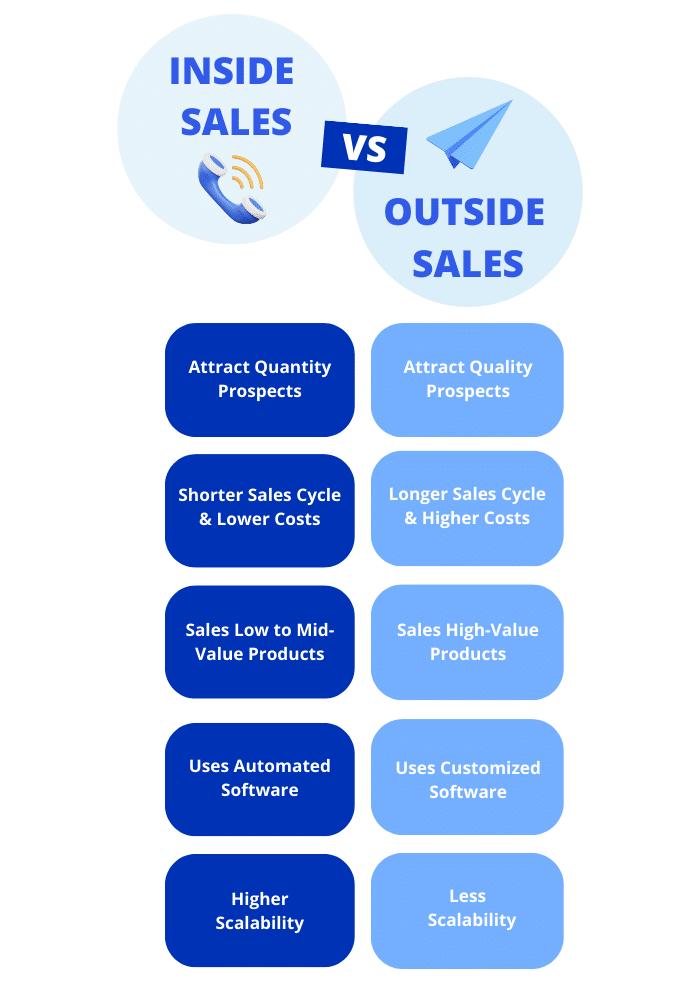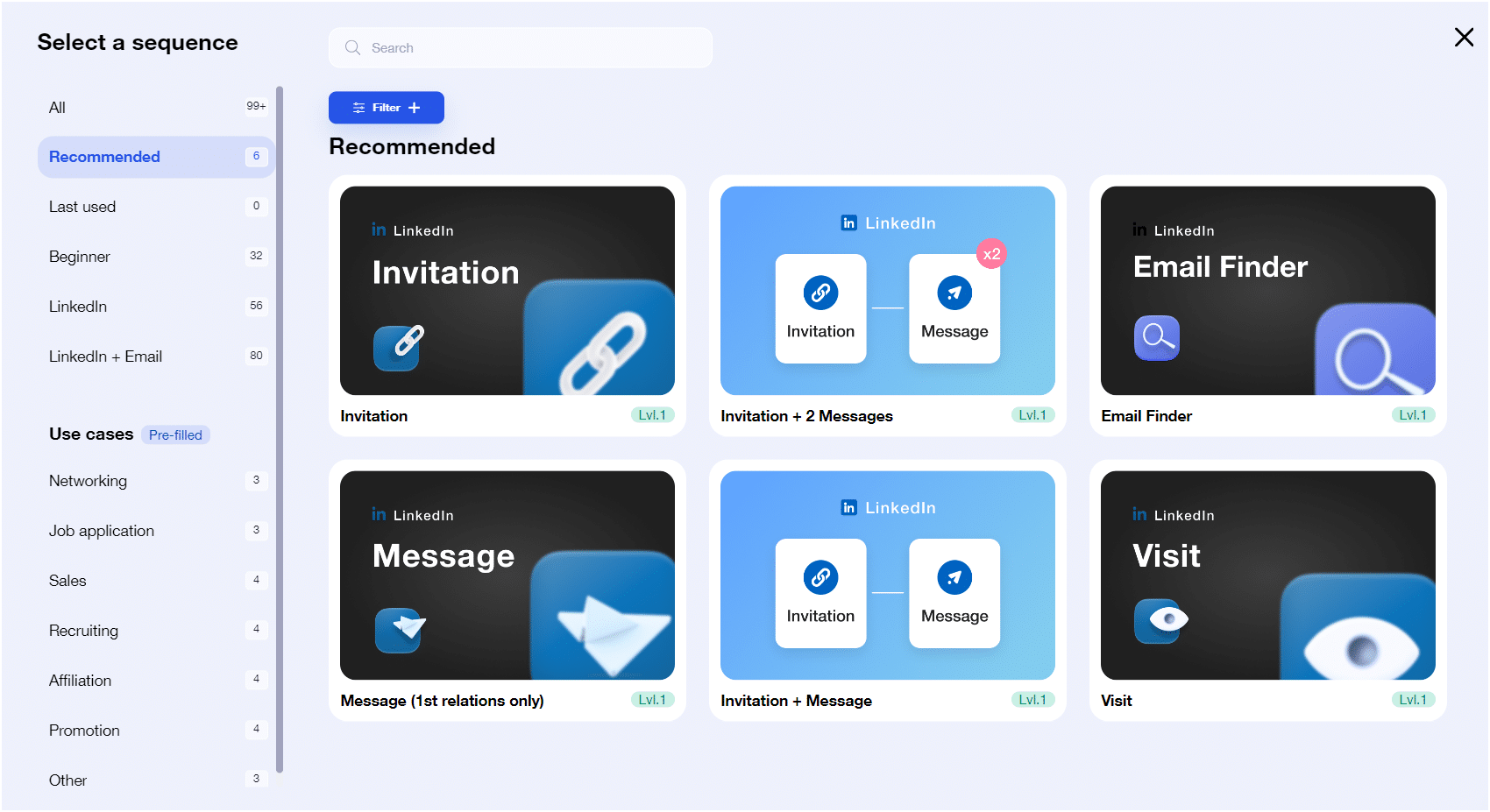Having an inside sales strategy has proven to be a powerful medium for companies to connect with customers, increase sales, and achieve notable sales growth. 🚀
In this blog post, we’ll explore the world of inside sales, its definition, benefits, tools, and more. We’ll also discuss the Top 5 most important inside sales strategies. ⚡
Inside Sales Definition: What Is Inside Sales?
Inside sales refers to a company’s sales strategy. 👉 Inside salespeople sell products or services remotely rather than meeting customers in person. Instead, they can use many tools like email, phone, and video calls for a more efficient sales approach.
Inside sales are popular in many industries, especially those that sell high-ticket items, such as B2B and technology. 📱 Of course, inside sales is more than just calling prospects and turning them into paying customers.
It’s also a marketing strategy using powerful tools like customer relationship management (CRM) platforms and strategies like search engine optimization (SEO), email marketing, and social media to increase sales season after season. 🍃
Furthermore, inside sales reps do not travel. ✈️ Instead, they write sales emails, answer customer questions, and call prospects to discuss their needs from their home or office.
Companies may also choose to outsource their office sales to a third party instead of hiring and training staff in-house. Discover how to create a successful outsourcing strategy here! 👈
Inside Sales vs. Outside Sales
Salespeople are well aware of the growing need for connected customer experiences that flow seamlessly from the first face-to-face contact. 🫶 As a result, many companies are considering the pros and cons of traditional field sales and how well it meets the needs of modern customers.
After years of inside sales representatives supporting their colleagues in the field, the advent of the internet has changed the way buyers and sellers interact with each other, meaning many companies are shifting their focus to keep up. 👀
That doesn’t mean field sales doesn’t have its benefits. 🏃 Some would argue that the imbalance in favor of inside sales fails to capture the value of face-to-face conversations. Of course, face-to-face interactions add value to a deal. 🏆 When salespeople travel to meet customers, it’s often easier to build trust and explain exactly how your product solves their problems.
For this reason, field sales is still part of the strategy for most companies. But as companies now look for ways to drive conversions at every stage of the sales funnel, establishing a skilled inside sales team is a smart way to capture the buyer’s attention. 💫

Top 5 Inside Sales Strategies for Businesses
To succeed in the world of inside sales, you need a repertoire of effective techniques to drive results and close deals. 🤝 In this section, I’ll discuss five powerful inside sales strategies that have proven successful for sales professionals.
Each strategy is presented with a guideline on how to use it. Let’s go! 💥
Strategy 1: Listen to your Prospects actively
In the world of inside sales, building trust with potential customers is not only beneficial; it is the basis for successful interactions and transactions. 🧱 Trust is the foundation of a sales relationship and allows for more effective communication and smoother transactions. One of the most effective techniques for building this trust is active listening.
But, what is active listening? 👂 Active listening means fully concentrating on the speaker, understanding the speaker’s message, responding thoughtfully, and remembering what was said.
This approach goes beyond just listening. 👉 The listener must be fully engaged and involved in the conversation.
Benefits of Active Listening in Inside Sales
- Deeper understanding of customer needs: 💡 Active listening allows salespeople to understand the specific needs, preferences, and pain points of their prospects. This detailed understanding is crucial for tailoring the sales approach to each customer’s unique needs.
- Builds trust: 🥰 When salespeople actively listen, prospects feel valued and understood. This can foster a sense of trust and rapport that is essential in any business relationship. Prospects who feel listened to are more likely to communicate openly and honestly and provide further insight into their needs and expectations.
- Reduce misunderstandings: ✔️ Staying focused on the conversation helps minimize misunderstandings. Active listening allows salespeople to clarify any ambiguities immediately, avoiding issues that may arise from misunderstandings.
- Improve customer satisfaction and loyalty: 💯 Customers who believe a company will meet their needs are more likely to be satisfied and remain loyal. Active listening contributes to a more personal customer experience, increasing satisfaction (CSAT) and fostering long-term loyalty.
Techniques for Effective Active Listening
- Reflect and clarify: 🪞 To demonstrate understanding, sales reps can rephrase what the prospect said or ask a clarifying question. This not only confirms that the message was received correctly, but also deepens the salesperson’s understanding of the prospect’s needs.
- Non-verbal signals: 👋 Using appropriate body language, such as nodding and eye contact (during video calls), emphasizes that the listener is engaged and attentive.
- Avoid interruptions: 🚫 Allowing the prospect to speak without interruption conveys respect and interest. It is important to let him finish his thoughts before you reply.
- Take notes: ✍️ Writing down key points helps recall details of the conversation and shows the prospect that their words are considered important.
- Follow up: 📨 Following up after the call with a summary of the discussion and next steps reaffirms the salesperson’s attention and commitment to meeting the prospect’s needs, you can do so via email or with a LinkedIn message, for example.
In fact, implementing active listening as a key strategy in your office creates trust and significantly improves the efficiency of the sales process. 💰
By fully understanding and addressing the needs of their prospects, sales professionals can build meaningful, productive customer relationships that lead to success!
Strategy 2: Nurture Client Relationships with Follow-ups
We’ve already introduced this idea in the previous step, but the follow-up process is not just a step, it’s a strategy that allows companies to stand out from their competitors. ✨
Personalized, timely follow-ups are essential to nurture leads, demonstrate engagement, and ultimately close the sale. 👏 This strategy keeps companies in the minds of potential customers and reinforces the perception of the value of their products and services.
Benefits of Timely Follow-Ups in Inside Sales
When it comes to following up, timing is crucial. ⌚ Forging the iron while it’s hot, when the lead’s interest is high, increases the likelihood of a positive response. 🔥 Timely follow-up also conveys a sense of urgency and professionalism, suggesting that the company is efficient and keeps the customer’s time in mind.
Furthermore, personalization in follow-up means going beyond generic messaging. 🪶 It involves tailoring your communications based on the prospect’s specific needs, interests, and previous interactions. 👄 This customized approach shows that the company sees the lead not just as a number, but as a valuable prospect whose needs matter.
Learn how to make personalized follow-up messages on LinkedIn! 👈
Techniques for Effective Follow-up Actions
- Use detailed notes: 📧 Tailor your follow-up using notes taken during the initial meeting or call, this can be done directly into your CRM or in the lead’s file. Mention specific points that were discussed, questions the prospect had, or personal details the prospect shared. This shows the lead that you are attentive and pay attention to detail.
- Segment your audience: 📍 Segment prospects based on similar needs or behaviors for more targeted follow-up. This allows for more specific messaging that can address the group’s unique concerns and interests.
- Choose the right medium: 📣 Depending on your prospect’s preferences, following up can be through email, phone, or even social media messaging. The key is to use the medium that your prospect feels most comfortable with.
- Good timing is key: 🗝️ Determine the best time to follow up. This can be based on industry standards, previous interactions, or specific instructions from the prospect about when they are most likely to make a decision.
- Provide value with every interaction: 🎁 Every follow-up should provide additional value to your prospect. This can be in the form of relevant information, helpful resources, or answers to previous questions. Don’t focus all your communications solely on closing the sale.
- Monitor and adjust: ⚙️ Monitor your follow-up responses and adjust your strategy as needed. If a particular approach or timing results in more engagement or positive feedback, use it as a template for future communications.
- Automate where necessary: 🤖 Use your customer relationship management (CRM tools) to automate follow-up tasks as needed. But don’t let automation take away from the personal touch that’s essential to building strong relationships.
By focusing on personalized, timely follow-ups, inside sales teams can significantly improve their relationship-building efforts. 💪 This strategy not only keeps your products and services in the spotlight, it demonstrates a true commitment to understanding and meeting potential customers’ needs.
The result is often stronger customer relationships, greater satisfaction, and increased sales revenue! 🚀
Strategy 3: Highlight your Social Proof
Social proof is a psychological phenomenon where people follow the behavior of others under the assumption that their actions reflect correct behavior. 👀 In inside sales, using social proof to demonstrate the success and satisfaction of existing customers can have a significant impact on purchasing decisions.
This strategy builds credibility and instills trust in potential customers, 👍 increasing their willingness to buy!
Benefits of Social Proof in Inside Sales
- Customer testimonials: 💘 Positive feedback from customers serves as a strong recommendation for a product or service. These testimonials may be featured on a company’s website, in marketing materials, and during sales presentations.
- Case studies: 🔍 Detailed descriptions of how your product or service helped solve a specific customer problem are especially compelling. They provide concrete examples of the value offered and make the benefits more tangible to potential customers.
- User ratings and reviews: ⭐ Displaying user-generated ratings and reviews on third-party platforms or on your website provides an unbiased assessment of our products and can have a significant impact on potential customers.
- Endorsements from industry experts: 🗣️ Affiliation marketing and positive mentions from respected industry figures add credibility and can attract potential customers who respect and follow these experts.
- Social media proof: 📱 Sharing user comments, stories, and posts on social media platforms can capture the attention of a wider audience and add a layer of credibility and relevance.
Techniques for Effective Social Proof
- Choose relevant testimonials: 👌 Choose testimonials that address common concerns and goals of your audience. This relevance will resonate more strongly with potential customers who have seen a similar problem successfully solved.
- Incorporate social proof early in the sales process: 🥇 Introduce social proof early in your conversations and marketing materials to establish credibility from the start. This creates a positive vibe for all subsequent interactions.
- Use variety: 🎥 By combining different types of social proof, you can address the different preferences and credibility of different potential customers. For example, some people prefer quantitative data from case studies, while others find video testimonials more persuasive.
- Update regularly: 🔔 Continually update your social proof to reflect current successes and keep your testimonials and case studies up-to-date. This demonstrates ongoing satisfaction and relevance.
- Make it easily accessible: ⚡ Make it easy for potential customers to find and review your social proof. Include it prominently on your website, emails, and presentations.
- Use multimedia: 🖼️ Use video, images, and audio whenever possible to make your social proof more engaging. Video testimonials, for example, are particularly effective because they can convey emotion and credibility better than text alone.
- Tell a story: Frame your social proof as a story that your potential customers can relate to. Stories are more memorable and more effective at illustrating a satisfied customer’s journey.
When used effectively in your B2b sales strategies, social proof can significantly increase the perceived value and credibility of your offer. 😍
By providing examples of customer satisfaction and success, 🙌 your sales team can inspire prospects’ trust, increase the likelihood of closing a sale and building long-term customer relationships.
Moreover, learn how to use storytelling to make your testimonials even more compelling! 👈
Strategy 4: Align your Marketing and Sales efforts
Collaboration between sales and marketing teams or “Smarketing”, can be a powerful growth driver for your company. 💥 When these teams are aligned on strategy and goals, they can significantly increase the effectiveness of your sales efforts through targeted campaigns, consistent messaging, and strategic use of marketing materials.
This collaboration not only helps you reach a wider audience, but it also leads to increased brand awareness and more qualified leads. 🧲
Benefits of Aligning Sales and Marketing
- Consistent messaging: 📩 Ensuring that both sales and marketing deliver a consistent message increases your brand’s reputation and authenticity. This consistency helps potential customers understand and trust your products and services, reducing confusion and reinforcing key value propositions.
- Efficient lead generation: 🎯 Marketing can use tools and channels to generate leads that sales can then nurture and close. When both teams work together, they can identify the most effective prospecting strategies and target the right audience with the right message at the right time.
- Improved customer understanding: ✅ Sharing insights and data between sales and marketing leads to a deeper understanding of customer behavior, customer preferences, and customer problems. This shared knowledge allows for more effective targeting and personalization of campaigns and sales approaches.
- Optimized resource utilization: 🤓 Alignment between sales and marketing ensures that resources are not wasted on disjointed or conflicting efforts. This ensures more efficient use of budgets and labor, optimizing the return on investment for both teams.
Techniques for Alignment between Sales and Marketing
- Regular communication and meetings: 🌐 Establish regular meetings and communication channels between sales and marketing teams. This allows for sharing updates, feedback, strategies, and keeps both teams aligned and informed.
- Jointly developed personas and journey maps: Jointly develop detailed “buyer personas” and journey maps that outline a customer’s typical journey from awareness to purchase. These tools will help both teams understand and address the needs and behaviors of their target audience at every stage.
- Shared goals and metrics: 🏹 Set shared goals and key performance indicators (KPIs) for sales and marketing. Not only does this ensure that both teams are working toward the same goals, it also promotes a sense of shared ownership.
- Create targeted content: 📺 Use insights gained from sales interactions to help your marketing team create content that addresses common questions, concerns, and objections from prospects. This content can be used by sales to train and nurture leads throughout the sales process.
- Feedback loop: 👂 Establish a feedback loop that allows sales to provide marketing with insight into what’s and what’s not working. This feedback is crucial for marketing to refine their strategy and materials to better support sales and lead generation.
- Use marketing automation and CRM: 👽 Use marketing automation tools and customer relationship management (CRM) systems to optimize and record all interactions with potential customers. This ensures that both teams have access to up-to-date information on the status and history of each lead.
- Create joint campaigns: 📅 Co-develop marketing campaigns from the planning stage through execution, ensuring all activities are fully integrated and aligned with your sales strategy.
Aligning internal sales and marketing efforts is not just about improving efficiency; it’s about creating a seamless experience that increases customer engagement, trust, and ultimately sales success.
By working closely together, sales and marketing can maximize effectiveness and provide a unified content strategy that leads to better business results! 🤑
Strategy 5: Analyze Data to make decisions
Finally, data-driven decision-making is a key strategy for your inside sales. 🔑 By harnessing the power of data and analytics, sales teams can gain deep insights into customer behavior, identify marketing trends, and optimize sales strategies.
This approach not only improves the efficiency of the sales process, but also improves the accuracy of forecasts and goals, ultimately leading to better sales results. 🤗
Benefits of a Data-Driven Inside Sales Strategy
- Improved customer insights: 🔎 Data analytics provide a comprehensive view of customer preferences, buying habits, and pain points. This information is invaluable for personalizing sales conversations and tailoring interactions to the specific needs of each prospect.
- Improved Lead Quality: 💎 By analyzing data from past interactions and outcomes, sales teams can better understand what characteristics make a lead more likely to convert. This allows for more targeted and effective lead acquisition.
- Optimized Sales Tactics: 🧲 Data reveals which sales tactics are most effective for different segments of your customer base. This allows sales teams to refine their approach and focus on strategies that produce the best results.
- Efficient Resource Allocation: 🪙 Analytics helps determine where to allocate resources for maximum impact. When companies know which areas generate the highest revenue, they can optimize budgets and staffing.
- Predictive Analytics: 💻 Advanced data analytics techniques help predict trends and customer behavior, allowing sales teams to proactively adjust their strategies. Predictive models can forecast sales trends, customer churn rates, and the success of advertising campaigns.
Techniques for Implementing Data-Driven Decision-Making
- Collect the right data: 🔬 Make sure you collect the right data from various sources such as CRM systems, social media interactions, website visits, customer feedback, etc. The data collected should be relevant and sufficient to make decisions.
- Use advanced analytics tools: 🛠️ Leverage advanced analytics tools that can process large amounts of data and provide actionable insights. These tools help you segment customers, predict trends, and identify sales opportunities.
- Train your sales team to use data: 🏃 It is important that your sales team understands how to use data effectively. It’s also important to use LinkedIn for sales team. Training to interpret analytical reports and use data insights in day-to-day selling is crucial.
- Integrate data across platforms: 🔗 Ensure data from different sources is integrated into a consistent system. This provides a 360-degree view of the customer and allows for more accurate analysis and forecasting.
- Review and adjust your strategy regularly: 🏹 The sales environment is fluid, and what works today may not work tomorrow. Review your data and analytics regularly and adjust your strategy as needed. This includes revising sales scripts, contact times, and follow-up strategies based on what the data shows.
- Create a feedback loop: 🌀 Establish a feedback loop for your sales team to report on the impact of strategies derived from analyzing data in the field. You can use this feedback to further refine your data collection and analysis processes.
Armed with data and analytics, 🔫 your inside sales team can move from reactive selling to a more proactive, strategic approach. This not only leads to more accurate sales efforts, but also more predictable, sustainable business growth.
A data-driven strategy empowers inside sales reps to stay one step ahead, 🧠 anticipate customer needs, and deliver timely, relevant solutions to improve sales performance!
Which tool to use for Inside Sales?
Now that you know how to implement these inside sales strategies, you might be wondering which tool to use? 🤔
Well, the answer is simple: the all-in-one tool for inside sales automation Waalaxy 🌌, of course! As a matter of fact, with our specialized software, you can easily:
- Generate more qualified leads,
- Perform your prospect qualification (via personalized prospect lists),
- Presentation of the offer and negotiation (via Email + LinkedIn messages),
- Customer monitoring and loyalty (via CRM integration),
- Custom and automated Follow-up campaigns.

More specifically, Waalaxy is a powerful tool to automate sales and marketing processes on LinkedIn. Here’s how you can use it for inside sales: 👇
- Determine your goals
Identify your target audience: Use LinkedIn’s advanced filters to find profiles that match your target market. You can filter by industry, company size, job title, region, etc. 💥 Then, export those leads: Once you have your list of leads, you can directly export them to Waalaxy to start managing them. - Create automated campaigns
Create campaign scripts: Waalaxy allows you to create custom scripts in which you can automate the sending of connection requests, follow-up messages, and even thank-you messages after acceptance. 🥰 Personalize messages: Make sure to personalize your messages to increase response rates with personalization tags like {firstName}, {lastName}, which will be replaced with the prospect’s name. - Monitor and analyze your performance
Use the sales dashboard: This tool provides detailed analytics on your campaign performance, including invitation acceptance rates, message replies, and more. 🔍 Adjust your campaign: Based on the data collected, adjust your message, follow-up times, and even goals to optimize your campaign performance. - Respect LinkedIn limits
Beware of activity limits: LinkedIn imposes limits on the number of invitations and messages users can send to avoid spam. 📩 Waalaxy offers settings to respect these limits and avoid having your account restricted or blocked. - Integration with other tools
Sync with your CRM: Waalaxy allows you to integrate your data with CRMs like HubSpot or Salesforce, 💻 allowing you to track all your interactions with prospects in one place.
With Waalaxy you can not only save time, ⌛ but also increase the efficiency of your inside sales efforts.
Conclusion: What are the Advantages of an Inside Sales Strategy?
Inside sales offers many opportunities for sales representatives and businesses alike. 🤲 By implementing effective strategies, leveraging the right tools, and continually improving your skills, you can succeed and maximize your revenue thanks to inside sales.
To conclude, here’s a recap of the main advantages of having an inside sales strategy in your company: ⏬
- Increasing profitability through technology,
- Sales reps have more time for the main tasks,
- Better client retention and satisfaction,
- Collaboration opportunities between teams.
Among others, but these are some of the benefits you get when implementing effective inside sales techniques. 😉 Remember, inside sales is not just a job. It’s a journey to build connections and create value for your business. You’re ready to go!
FAQ of Inside Sales
What is the best Inside Sales tool?
For Inside Sales, choosing the right tool depends on your specific customer relationship and automation needs. 🤖 Waalaxy is a great choice for automating LinkedIn interactions, allowing you to target and engage prospects with personalized campaigns. It’s especially useful for automating connection requests and follow-up messages, while still respecting LinkedIn’s limitations.
Another powerful tool is HubSpot Sales Hub, which provides a comprehensive platform to manage the entire sales process. 🤝 It includes features like email tracking, appointment scheduling, and real-time lead insights.
Choosing between Waalaxy for a specific automation on LinkedIn + Email or HubSpot for a more integrated solution will depend on your sales strategy and target audience.
Great, you know all about the best Inside Sales Strategy! 🤩













